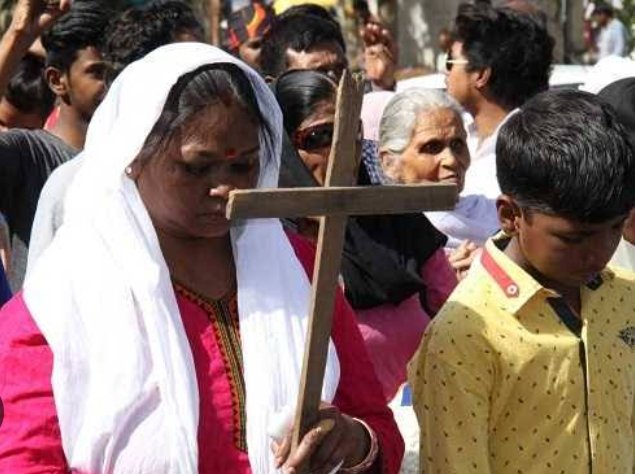Christian—Tribal Conflict Has Old Fault Lines


Even as the vexed issue of conversions, from one faith to another, is being argued in the Indian law courts, it continues to leave behind a bloody trail, as Mahatma Gandhi had warned on numerous occasions.
The new year started on a violent note in Narayanpur in Chhattisgarh. On January 2, unrest simmering for months in the area, imploded. Local tribals and recent converts to Christianity were arraigned against each other. Each side is accusing the other, of orchestrating violence.
The conflict is not a sudden development. In a note in July 2021, the Sukma superintendent of police Sunil Sharma first flagged the possibility of conflict. “Christian missionaries and converted tribes are reaching the interiors of the district and are luring local tribals. We cannot deny the possibility of conflict between converted tribals and locals.” The expression “luring local tribals”, neatly sums up the problem.
Who threw the first stone or provoked violence in Narayanpur– tribals or converts– is for the police to investigate and law Courts to decide. But the reasons leading to this ugly situation are all too familiar. The tribals (Janjatis as the constitution defines them) have a unique life style, distinct culture, and indigenous modes of worship- shaped by their continued engagement with nature.
Fired by their exclusivist dogma- ‘extra ecclesial nulls salts (outside the Church, no salvation), Christian missionaries are committed to bring all non- believers into Jesus’s fold. The second century theologian Tertullian, known as the father of Latin Christianity, said, “the blood of martyrs is the seed of the Church”, emphasising Church’s deep commitment to its evangelical agenda. It’s not a rhetoric, but real.
In 2018, John Allen Chau, 27, an American evangelical fell to the arrows of local tribals in Andaman Islands when he made a third attempt to reach and convert them. The tribe— Sentinelese, protected by law, lives in voluntary isolation. Allen knew his actions were illegal and entailed danger to his life. His love for Jesus, however, overshadowed love for his own life and respect for law and tribals’ right to live by their own beliefs. He considered their habitat as the ‘satan’s stranglehold’, and wrote in in his diary, “I think it’s worthwhile to declare Jesus to these people.”
Such invasive activities, reeking of medieval mindset, are out of sync with modern value system which recognises individual rights on what to eat, wear and believe or not to believe in. Proselytisation implies demeaning other person’s faith. It assumes non – Christian faiths are inadequate, deserve to be exterminated. Can a civilised society allow an organised group to take upon itself— that too in the name of God—questioning of other people’s choice of faith – offer allurements, use fraud or fear – to obliterate their identity? Evangelisation amounts colonisation of spirituality space.
Faced with such cultural onslaught by missionaries, the targeted groups, view the church, as an alien agency, and resent the outside intrusive influence, sometimes resulting in bloodshed. This is exactly what Mahatma Gandhi had warned about.
In a letter to Christians of Kerala (published in Harijan of January 30, 1937) Gandhiji asked, “Why should a Christian want to convert a Hindu to Christianity and vice versa? … insistence on a particular form or repetition of a credo may be a potent cause of violent quarrels leading to bloodshed and ending in utter disbelief in religion, i.e., God Himself. “How prophetic Gandhi Ji was! In Europe Christianity is on decline. An increasing number of European Christians are deserting the Church and turning atheists and agnostics.
Aggressive evangelisation does lead to bloodshed at times. Swami Lakshmanananda Saraswati and four of his disciples were murdered on 23 August 2008 in Kandhamal district of Odisha. Saraswati, a Hindu monk, worked for the welfare of tribals and opposed the missionary activities in the area. Seven Christians and a Maoist leader were convicted in the case.
In despicable gory incident, Graham Stuart Staines, an Australian missionary and his two sons were burnt to death in 1999, by some Bajrang Dal activists, led by one Dara Singh. Staines was an evangelist, active in Odisha since 1965 and was accused of converting tribals through inducements and force.
Way back in 1954, Congress ruled Madhya Pradesh appointed Niyogi Committee. Its report published in 1956, says the Roman Catholic missions used money-lending as a device for proselytisation. They gave loans which were later written off if the debtor became Christians. Because of the social tensions that evangelisation creates, as many as nine states have passed their own anti-conversion laws.
Various interested groups have challenged anti-conversion laws in Courts. On January 16 last, the Supreme Court advised the petitioners to compile all the petitions challenging the anti-conversion laws in various states and move a consolidated transfer petition so that the cases can be transferred to the top court.
Article 25 of Indian Constitution guarantees freedom of conscience, freedom to profess, practice and propagate religion to all citizens, subject to public order, health and morality. The issue is: Can the right to propagate religion stretched to undermine others’ faith and disturb social balance? Can the state allow activities that generate social tensions and transgress limits of morality? Evangelisation exercises include offering ‘miracle cure’ for hopeless medical conditions through ‘Changai sabhas’ and transacting hapless souls for ‘succour’ extended in difficult times. We will have to wait for apex Court’s verdict to know answers.
Mr. Balbir Punj is a Former Member of Parliament and a Columnist.
punjbalbir@gmail.com
DISCLAIMER: The author is solely responsible for the views expressed in this article. The author carries the responsibility for citing and/or licensing of images utilized within the text.
